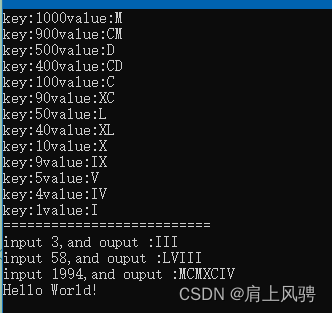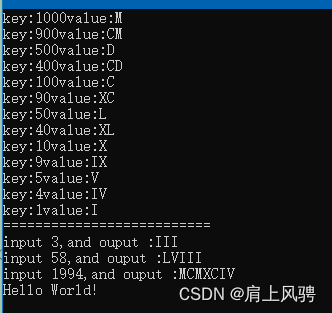map按照从大到小存储元素
- 引言
- map的大致介绍
- 概述
- 场景
- 误区
- 示例
- 示例代码(方法一)
- 运行结果
- 示例代码二(方法二)
- 运行结果
引言
在对map的使用中,由于对业务的需要,希望map中存储元素能够按照键的大小从大到小的顺序递减存储元素,但之前没有对这块进行了解,只是想当然的使用sort来对map中的元素进行排序,但是不能这样操作的。
本文记录如何对map中的元素按照键的大小从大到小进行递减的存储元素。
map的大致介绍
概述
map是C++标准容器中的一种,也是一种关联容器,用于存储键值对,内部使用红黑树实现,可以快速查找和插入。其存储的元素默认按照键的大小从小到大的递增。
场景
由于map中存储的元素默认是按照键的值从小到大的顺序进行存储的,但是业务却希望map能够按照键的值从大到小的顺序存储元素。
误区
我的第一反应是使用sort函数来对map进行排序,但是后来发现sort排序后编译器编译不通过,反复修改折腾,最后才知道sort函数要求传入的容器迭代器类型为随机访问迭代器。而只有vector,deque和array等序列容器可以通过sort排序。
示例
本例子是一个map我想把内部的元素按照键的值从大到小的顺序存储。
示例代码(方法一)
第一种方法是通过一个类,在类中实现一个仿函数,仿函数主要是实现比较键的大小,使mapd的键按照我们预期的顺序排序。下面是示例代码。
main.cpp
#include <iostream>
#include <string>
#include <map>
#include <algorithm>
using namespace std;struct mapSort
{bool operator() (const int& a,const int& b) const{return a > b;}
};map<int, string, mapSort> hashPair = { {1000, "M"}, {900, "CM"}, {500, "D"}, {400, "CD"},{100, "C"}, {90, "XC"}, {50, "L"}, {40, "XL"},{10, "X"}, {9, "IX"}, {5, "V"}, {4, "IV"},{1, "I"} };class Solution {
public:void printPairs() {for (const auto& var:hashPair){cout << "key:" << var.first << "value:" << var.second << endl;}cout << "==========================" << endl;}Solution() {printPairs();}string intToRoman(int num) {string strValue;for (const auto& /*[value, symble]*/var : hashPair) {int value = var.first;string symble = var.second;while (num >= value) {num -= value;strValue += symble;}if (num == 0) {break;}}return strValue;}
};int main()
{Solution obj;// 3 58 1994cout<<"input 3,and ouput :"<<obj.intToRoman(3)<<endl;cout << "input 58,and ouput :" << obj.intToRoman(58) << endl;cout << "input 1994,and ouput :" << obj.intToRoman(1994) << endl;std::cout << "Hello World!\n";
}
上述代码中,map<int,string>的键为int,若是按照键的值从大到小的顺序存储,需要定义个一个类或者结构体,在其中写一个仿函数bool operator() (const int& a,const int& b) const,通过这个仿函数来实现容器的键的比较,使其按照键的值从大到小的顺序的存储。定义map的时候,需要在键值类型的后面加上该类的名称,map<int, string, mapSort>其中mapSort就是仿函数实现键排序的类。这样map中的元素就可以按照键的值从大到小进行排序了。
运行结果

示例代码二(方法二)
第二种方法是定义一个函数,该函数与上述的仿函数功能一致,就是使map的键按照期望的顺序从大到小排序,然后将这个函数定义为一个函数指针,最终在定义map的时候,将函数指针座位参数传入。不过map的初始化就要放在后面单独进行了。
#include <iostream>
#include <string>
#include <map>
#include <algorithm>
using namespace std;bool compare_map(const int& a, const int& b)
{return a < b;
}
bool(*fun)(const int&, const int&) = compare_map;
map<int, string, bool(*)(const int&, const int&)> hashPair(fun);class Solution {
public:void printPairs() {for (const auto& var:hashPair){cout << "key:" << var.first << "value:" << var.second << endl;}cout << "==========================" << endl;}Solution() {hashPair[1000] = "M";hashPair[900] = "CM";...//这里省略部分插入操作,实则需要写上hashPair[1] = "I";printPairs();}string intToRoman(int num) {string strValue;for (const auto& /*[value, symble]*/var : hashPair) {int value = var.first;string symble = var.second;while (num >= value) {num -= value;strValue += symble;}if (num == 0) {break;}}return strValue;}
};int main()
{Solution obj;// 3 58 1994cout<<"input 3,and ouput :"<<obj.intToRoman(3)<<endl;cout << "input 58,and ouput :" << obj.intToRoman(58) << endl;cout << "input 1994,and ouput :" << obj.intToRoman(1994) << endl;std::cout << "Hello World!\n";
}
bool compare_map(const int& a, const int& b)是比较函数,实现将map的键按照从大到小的顺序进行比较,后面定义了函数指针,map定义的时候指明了传入的函数指针,最后插入元素,被插入的元素会按照从大到小的顺序存储。
运行结果

以上可以参考博文:
https://blog.csdn.net/weixin_42686879/article/details/117092701


笔记1)
)













及外部API接口请求)

